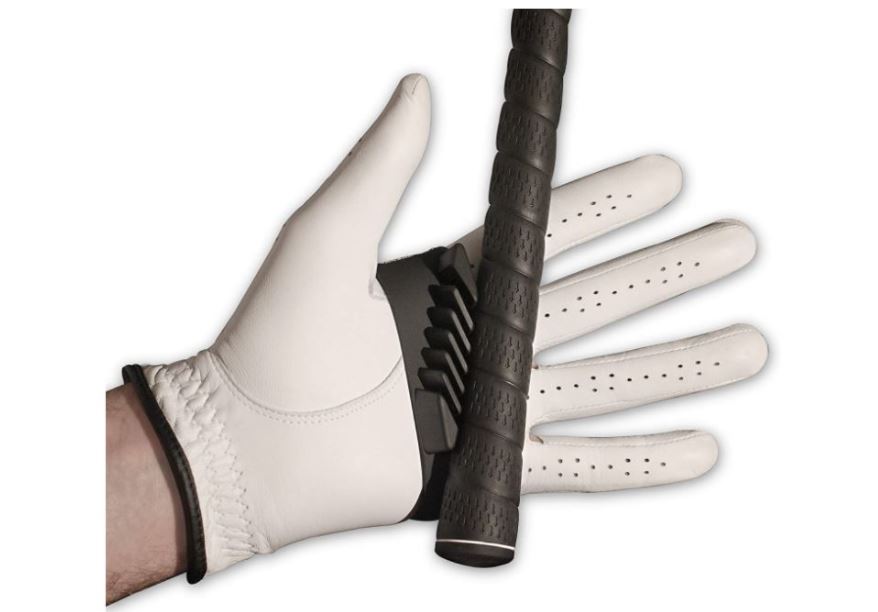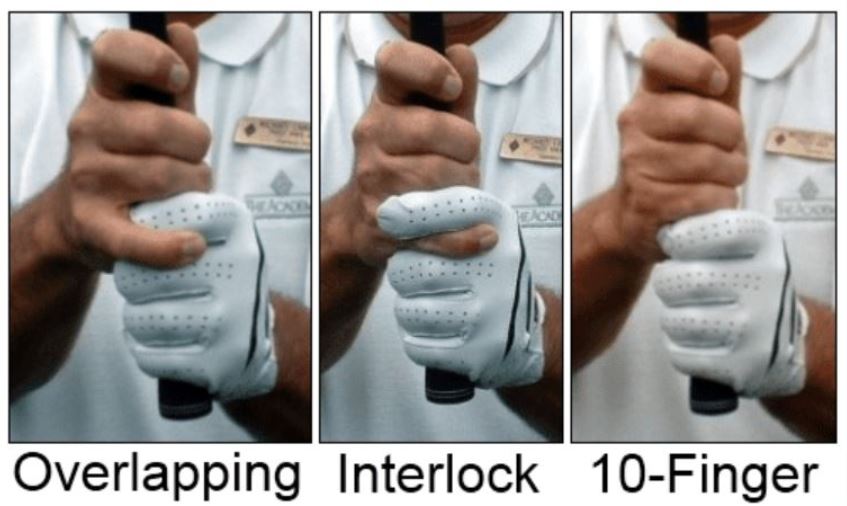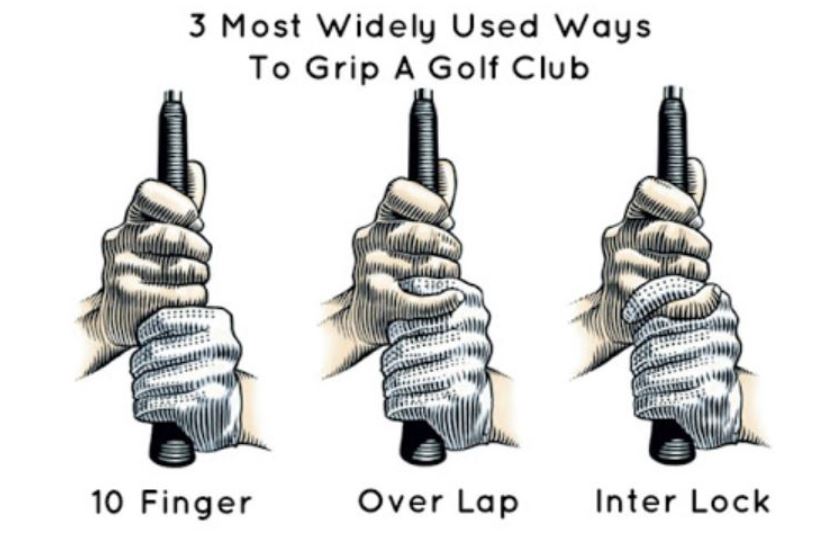What Are The Pros And Cons Of The Interlocking Golf Grip

As amateur golfers, we turn to new and innovative golf equipment to improve our scores. However, not even the best clubs in the world can make you a better player. It is all in the mechanics of your swing and the strength of your mind.
Before you analyze your swing, you need to determine whether or not you are playing with the correct grip. In this post, we are looking at the pros and cons of the interlocking grip, And while legends like Tiger Jack and Rory used this grip, we will help you decide if it can work for you.
Why Your Golf Grip Is Important?

The grip you choose to use will impact your swing path and the point of impact. A strong grip may prompt you to hook your shots if your rhythm is off. Conversely, a weak grip can lead to a nasty slice.
Golfers use three main grip types, the ten-finger, interlocking, and Vardon grips. A less common option is the back-handed grip.
What Are The Different Options For Golf Grips?

Three common grip types exist, The ten-finger, interlocking, and the Vardon grip. The ten-finger is a neutral grip, where players grip the club the way they would a baseball bat. Hence its nickname, the “baseball grip.”
This grip is the easiest for beginners to use and can help you generate maximum levels of swing speed. However, your hands operate independently of one another and can cause you to slice or hook your shots.
The interlocking grip is also known as a strong grip, which promotes a draw shape. Although it offers you maximum control, it is the least comfortable of the predominant golf grips.
Golf’s most used grip is the Vardon setup. It is a weaker grip where your hands overlap. Although this grip will cost you distance, it is the most conservative of the grip options.
There is one other grip option, but it is rare to see, and that is the back-handed grip. It was made popular by the South African golfer Sewsunker “Papwa” Sewgolum. The reason it is less common is that your leading hand sits at the top of the club.
What Is The Interlocking Golf Grip?
An interlocking grip is a strong setup, which promotes a draw shape, resulting from the in to out swing path.
If you struggle with a slice or want to mitigate against a fade, it may be worth trying out the interlocking grip.
How To Make An Interlocking Golf Grip?

To make the grip, place your strongest hand on the club with your palm facing upwards.
Next, place your weaker hand on the club, and lock your stronger pinky finger between your weaker index and middle finger. Finally, wrap the pinky around so that it is touching your grip.
What Are The Advantages Of The Interlocking Golf Grip?
- Promotes a consistent draw shape
- It offers you more control than any other grip
- Ideal for players with smaller hands
- Suits golfers with faster swings
- Provides more clubhead stability at impact
What Are The Disadvantages Of The Interlocking Golf Grip?
- Unnatural feeling when tried for the first time
- Uncomfortable for players with big hands
- It reduces wrist motion and power, reducing the distance for some players
- Not ideal for slower swinging players
- Can induce duck hooks if your rhythm is off
Who Should Be Using An Interlocking Golf Grip?
According to an article by Foresight’s Sport, an interlocking grip is best suited to golfers with smaller hands. The reason for this is that it is an uncomfortable setup for players with bigger mitts.
Hand size aside, an interlocking grip is ideal for golfers who are slicing their shots. Since a weaker grip can cause your face to open at impact and lead to a slice, an interlocking grip would help mitigate this.
Should High Handicappers Use The Interlocking Golf Grip?
I always recommend that beginners and high handicappers use a ten-finger grip or an overlapping grip. The reasons for this are to do with comfortability. Starting golf or trying to lower your scores is overwhelming enough without having to worry about your grip.
A baseball grip will be comfortable and will allow you to focus on your aim, distance control, and swing. An interlocking grip can feel unnatural, and if your swing is still a work in progress, it can lead to long days on the course.
With that in mind, you may take to an interlocking grip immediately and find it works best for you.
Should Pros Use The Interlocking Golf Grip?

The grip a Pro uses depends on their preference. They are professionals and will use what works best for them.
Tiger Woods, Jack Nicklaus, and Rory McIlroy have all use an interlocking grip and have enjoyed incredible success. However, the majority of players on the Tour use an overlapping grip.
Is An Interlocking Grip A Strong, Neutral, Or Weak Golf Grip?
An interlocking grip is also known as a strong grip. When the pinky finger of your strong hand locks around the index finger of your supporting hand, it creates a maximum level of tension on the grip, leading to a more closed clubface at impact.
However, you can neutralize an interlocking grip. If you are a right-hander, loosen the grip of your left hand. Conversely, left-handers should loosen the grip of their right hand.
Luke Kerr-Dineen from Golf.com explains how Tiger achieved a neutral interlocking grip in this article.
Signs That You Are Using The Wrong Golf Grip?
If you are slicing or hooking your shots, you are likely using the wrong grip. It prompts a wayward swing and results in long days on the course.
Overall if your grip is too strong, you may consistently hook your shots. Conversely, if your grip is too weak, it may induce a consistent slice.
If you are hooking your shots, it is worth trying a neutral or overlapping grip that is weaker and will cause your clubface to be more open at impact. That will mitigate against your hook and keep you in play.
On the other hand, if you are slicing the ball, you will want to strengthen your grip, to prompt a closed face at impact.
Do I Need To Use The Same Grip For Every Club?
No, you do not need the same grip for every club. Players often use a different putting grip to the grip they employ with their driver or irons.
I use a ten-finger grip for my woods and irons but a back-handed grip for putting.
Should I Consider Switching To An Interlocking Golf Grip?
If you are slicing your shots consistently and feel that you lack control with a neutral grip, it is worth tinkering with an interlocking grip.
However, it is not the most comfortable grip, and unless you are a solid ball striker, you will not achieve the distance you may from a ten-finger or overlapping grip.
Conversely, if you pull your shots, your clubface is likely closed at impact. The root cause of this problem is most likely a strong grip.
The remedy is to weaken your grip using a neutral or Vardon technique that prompts the clubface to open at impact, compensating for your tendency to pull or hook shots.
What Grip Does Tiger Woods Use?

Tiger uses an interlocking grip. When he turned Pro, he played with a strong interlocking grip.
However, as he worked with Butch Harmon, he weakened his left-hand grip leaving him with a unique neutral interlocking grip.
Golf.com’s Luke Kerr-Dineen notes that he went back to a strengthened interlocking grip for a short period before switching permanently to a neutral interlocking grip.
What Grip Does Rory McIlroy
Like his friend Tiger, Rory McIlroy uses an interlocking grip. However, he employs a firm interlocking setup.
Interlocking Vs Overlapping Golf Grip

Generally speaking, the interlocking grip is stronger than an overlapping approach. Legendary players have used the interlocking grip. But, the overlapping grip is the most commonly used setup in golf.
An interlocking grip ensures that all ten fingers touch the club, prompting your hands to work in unison on your backswing and follow-through.
The setup of the interlocking grip will prompt a closed clubface at impact, which can lead to a hook. However, this grip is ideal for players trying to draw the ball.
The overlapping grip was popularized by Harry Vardon, who holds the record for the most British Open titles, with six victories. I will use an example of a right-hander to explain how to make this grip.
Grab the club with your right hand, and ensure that your palm is facing down. Add your left hand to the grip, and rest your right pinky on the knuckle of your left index finger, as explained by Australian PGA coach Brian Fitzgerald.
Interlocking Vs 10 Finger Golf Grip

While an interlocking grip may be associated with legendary players, beginners commonly use the 10-finger golf grip setup.
The reason is that it feels more natural than an interlocking grip, making it easier to pick up.
The 10-finger grip is also known as a baseball grip. Your hands work independently of one another, which can induce a slice and the odd hook when your tempo is off.
However, this grip helps you generate more power than any other grip because all ten of your fingers are touching the club.
To make a baseball grip, grab the club with your support hand, and wrap four fingers around the club. Then point your thumb directly down the shaft.
Next, place your leading hand onto the grip, and ensure that the bottom palm covers the tip of your supporting hand’s thumb. Your lead thumb should also be pointing directly down the shaft.
Beginners generally gravitate towards the 10-finger grip and then adopt an overlapping setup as they progress. However, I have used it for most of my 27 years in golf.
I did switch to an overlapping grip for a few months in my teenage years but immediately reverted to the baseball setup.
Overall, the 10-finger grip is more comfortable, easier to get used to, and delivers more power for the average golfer. Conversely, the interlocking grip is uncomfortable and reduces power for those with moderate to slow swing tempos and average ball-striking abilities.
Most Comfortable Golf Grip
I mentioned above that the 10-finger or baseball grip is the most comfortable grip, especially for beginners or high handicappers.
It comes as no surprise, as this grip requires the same setup used on a racquet or baseball bat.
Best Grip For Power
Out of the three predominant grips, the 10-finger grip delivers the most power at impact.
Since all ten fingers are touching the grip, it enables you to enhance energy transfer from club to ball.
Best Grip For Control
It may not be the most comfortable setup, but the interlocking grip offers you more control than the other setups.
Since your hands interlock the work in unison, giving you a fluid motion and offering more control over your clubhead and swing.
Best Grip For Putting
The grip that I recommend employing for putting is the backhanded or Sewsunker grip.
While the grip will feel awkward, it does wonders for your speed control on the dancefloor.
The Sewsunker grip prevents you from overcooking your putts and helps to induce a pendulum motion on your backswing and follow-through.
Conclusion On The Interlocking Golf Grip

Golf’s three dominant grips prompt various shot shapes, distance, and accuracy.
While the ten-finger grip is the most natural and comfortable setup to employ, your hands operate independently. That can cause you to hook and slice your shots.
Conversely, the interlocking grip is one of the stranger setups to adjust to, but it provides more control over your club.
Even though it works for Rory and Tiger, I suggest that mid to high handicappers use a 10-finger or overlapping grip for more comfort and power.
Watch this video from Scratch Golf Tips if you need a visual demonstration of an interlocking grip setup.
Aidan Lehane here, I’m a Mid-low handicap golfer who has made tremendous progress in breaking 90 in just over 1 year of playing golf seriously.
I get out to the course or range as often as possible and review all the equipment I’ve come across on this blog.
